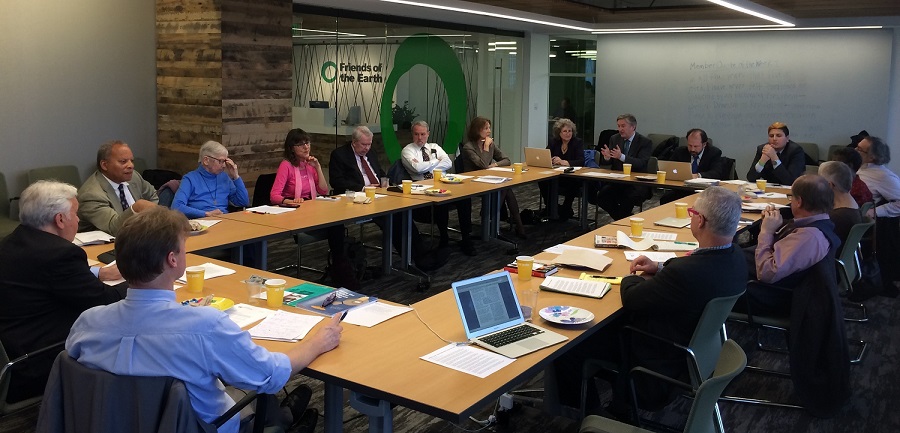Doomsday clock moved to 2.5 minutes to midnight.
PNND and UNFOLD ZERO hold a consultation on opportunities to make progress provided by upcoming multilateral processes.
Doomsday clock moved to 2.5 minutes to midnight.
PNND and UNFOLD ZERO hold a consultation on opportunities to make progress provided by upcoming multilateral processes.
The world is 30 seconds closer to nuclear annihilation, according to the Bulletin of Atomic Scientists who today moved the hands of the 'Doomsday Clock' to 2.5 minutes to midnight.
Speaking at a press conference in Washington DC, Lawrence Krauss, a theoretical physicist who chairs the Bulletin of the Atomic Scientists' Board of Sponsors, noted that the Doomsday Clock, is an “indicator of the world’s vulnerability to catastrophe from nuclear weapons, climate change and new technologies.”
That vulnerability worsened since the last yearly update. “This year’s Clock deliberations felt more urgent than usual…as trusted sources of information came under attack, fake news was on the rise, and words were used by a president-elect of the United States in cavalier and often reckless ways to address the twin threats of nuclear weapons and climate change,” said Rachel Bronson, executive director and publisher of Bulletin of the Atomic Scientists. (Click here for the full statement).
Meanwhile, a few blocks away, UNFOLD ZERO, Green Cross International and Parliamentarians for Nuclear Non-proliferation and Disarmament (PNND) hosted a consultation of arms control experts and disarmament activists to discuss how to reduce nuclear risks and support nuclear disarmament in the new political environment.
The meeting, part of a series of consultations in Geneva, Vienna, New York, Washington, London and other centres, was opened with presentations by Paul Walker, Program Director of Green Cross International and Alyn Ware, PNND Global Coordinator.
It focused on possibilities for progress provided by upcoming multilateral processes, including United Nations negotiations on a treaty to ban nuclear weapons, the resumption of the Non-Proliferation Treaty review cycle and the 2018 UN High Level Conference on Nuclear Disarmament.
The nuclear ban treaty negotiations, which start in March this year, have attracted considerable interest, especially as it seems quite possible that the treaty could be concluded within a year. However, the USA and other nuclear-armed States are unlikely to join the ban treaty negotiations, and will not be bound by the treaty if they do not join.
The NPT review cycle is important, as the NPT contains a treaty obligation to achieve nuclear disarmament. However, the 2017 meeting is only a preparatory meeting for the full review conference in 2020. And many agreements from previous NPT review conferences go un-implemented.

The UN High Level Conference on Nuclear Disarmament (HLCD) could provide a unique and powerful pressure point on the nuclear-armed States.
Recent UN conferences on climate change, sustainable development goals and refugees have been very successful in elevating political, public and media attention to these issues and achieving global agreements.
The HLCD is already supported by over 140 countries, including some of the nuclear-armed States. This could help put pressure on the USA and other nuclear-armed States to participate and deliver or adopt significant measures at the HLCD.
On the other hand, the new Trump administration has indicated some ambivalence to the UN and international agreements.
One thing that might positively influence the US approach to the HLCD is whether or not the proposed US/Russia Summit goes ahead and if so, whether it produces a bilateral agreement on reducing nuclear risks and stockpiles. if so, this could pave the way for plurilateral and/or multiateral agreements at the HLCD.
It was noted that action in the Security Council, perhaps led by non-nuclear members such as Kazakhstan, Japan or Sweden, could also pave the way for a successful HLCD. The President of Kazakhstan has already announced that they intend to use their position on the Security Council to advance nuclear disarmament.
Other points that were noted as important at the PNND consultation were; the need to increase cooperation between different constituencies, highlight ‘pocket book issues’ (like nuclear weapons spending) and educate public and policy makers on the increased capacity for cooperative security mechanisms to address key security concerns and to replace nuclear deterrence.
These are key elements in 'A Nuclear-Weapon-Free World: Our Common Good' the joint statement of mayors, parliamentarians and religious leaders which was circulated at the consultation.
PNND, Mayors for Peace and Religions for Peace plan to present the joint statement to the UN Secretary-General and to governments in order to support nuclear-risk reduction and disarmament measures and multilateral processes including the NPT, nuclear ban treaty negotiations and 2018 UN High Level Conference.
No single strategy was identified at the consultation as being the most effective in moving the US and other key governments to adopt nuclear risk reduction and disarmament measures. Rather, there was general support that advancing multiple tracks of both incremental and comprehensive measures provides the highest probability of success.
There was also recognition that, in light of ambiguous remarks by President Trump about nuclear weapons use policies, the issue has regained media and public attention. This provides opportunities to gain media coverage of nuclear disarmament events, proposals and processes, and to build deeper engagement with other civil society constituencies.
Air Max